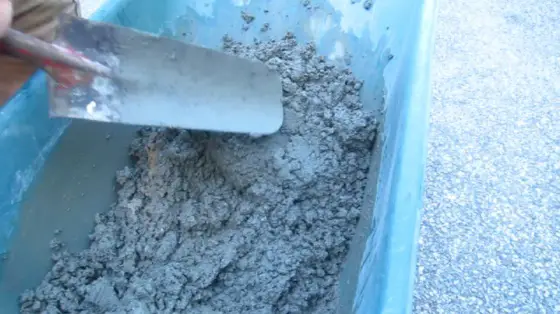How to Mix Concrete Like a Pro

Here’s some concrete in a wheel barrow that’s been mixed by hand and it nearly perfect in consistency. Photo Credit: Tim Carter
How to Mix Concrete
Quick Column Summary:
- Concrete finish is rough
- Best mix of stone, sand and cement
- How to determine slump of concrete
- Good finishing ideas
DEAR TIM: I'm going to do an ambitious concrete project this summer pouring a long sidewalk. My initial results are disappointing. The finish I'm getting on my concrete is rough and too many stones are at the surface. I wonder if I have my mix proportions wrong or what else may be the problem. Can you help me mix concrete like the pros do? Should I purchase an electric mixer? Richard S., Lakeside, CA
DEAR RICHARD: Your project brought back a flood of great memories that you'll enjoy. When I was a young teenager, I played and went to grade school with the Boncutter kids. Their dad, Mr. Boncutter, had a night job working at the manufacturing plant where bagged concrete was invented. It was the Sakrete plant in St. Bernard, Ohio.
The plant manager allowed Mr. Boncutter to salvage spilled Portland cement that fell onto the floor as the sacks were filled. Mr. Boncutter used this Portland cement to pour a massive concrete apron, one small section at a time on a different day, in the rear of an apartment building he owned. He wanted to do it himself just like you do and he had plenty of time. He also had some free material and free labor from his kids and their friends like me.
I discovered at the ripe age of thirteen, how to mix concrete by hand and get it right. Please be aware that concrete is a very complex material and you could fill a small library with the technical books and papers written about all the aspects of it. For our discussion, we'll be talking about very basic concrete.
Most concrete experts will probably agree that the proportions of ingredients for a standard concrete mix are: three parts stone, two parts medium or coarse, clean, washed sand, one part Portland cement and just enough water to make it a plastic mix.
The stones, or aggregate, in the concrete are what make concrete strong. The bigger the stones, the stronger the concrete for the most part. But there's a critical relationship to the largest stone you should have in the mix depending on the thickness of the slab you're pouring. The diameter of the stones in the mix should never exceed one-third the thickness of the slab you're pouring.
This means if your sidewalk will be 4 inches thick, the largest stone should be no more than 1.333 inches in diameter. It's best that you have a blend of stones in your mix that range from say 0.5 inches up to 1.25 inches in size.
When you decide to mix concrete by hand, I was taught to blend the stone, sand and Portland cement powder together DRY before you add water. You want the dry mixture to be uniform and the same color.
Realize the Portland cement is the binder or glue that holds the sand and stone together once the concrete cures. You can add more cement to your blend if you want, just be sure you add the same exact amount to each batch. I would probably increase my ratios to: three parts stone, two parts sand and one and one-half Portland cement.
Water is both your friend and foe when mixing and pouring concrete. If you add too much water to the mix, you dilute the amount of cement paste that coats the sand and gravel. If you add too little, you make it very hard to place and finish the concrete.
Professionals can place and finish concrete that's got minimal water in it because they have special machines that can vibrate the concrete to produce an acceptable finish that's almost impossible to achieve doing it by hand.
The proper amount of water to add to your dry ingredients is enough so that once blended the concrete is fully wet but not so wet that it won't stay up in a pile. Professionals refer to this as slump. The higher the slump number, the more water you have in the mix.
If I were to order concrete from a ready-mix plant that came in a truck to the job site, I'd order a 4-inch slump for a sidewalk job. This mix flows down the chute of the concrete truck and can be placed in forms by an experienced crew.
You can mimic this 4-inch slump by making sure the concrete in your wheelbarrow, once mixed, will stay up on the sides of the wheel barrow and not fall back down into a flat level surface in the wheelbarrow. If the concrete mix acts like a thick gravy then you have far too much water in it.
Your disappointing finish results may have been a rookie error. It's entirely possible you mixed the concrete correctly but didn't place it right. You may have put the concrete mix in the forms and not worked the mix to drive the stones just below the surface while the mixture was still in the plastic state. Professionals use a tool called a bullfloat or a vibrating power screed to do this.
Column 1039
4 Responses to How to Mix Concrete Like a Pro